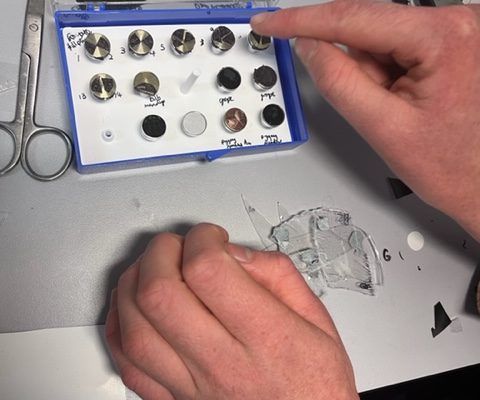I am in a science lab in the biology department at the University of Bristol. The desk in front of me is a pleasing chaos of collected objects and scientific equipment – remnants of foraged berries dried on their branches; yellow lidded test tubes; neat rows of metal stubs with carbon tape discs on them; display books of carefully labelled microscope slides; lab books full of scribbled ideas and results.
The desk belongs to Rox, a physicist who studies a rare shimmery colour of blue in nature and the structures that produce this. Rox is our academic collaborator on The Beauty Project. In her research, Rox has been looking again and again at the minutiae of these. Suspending them in resin allows her to cut them into segments so thin that to the eye it almost appears as if there is nothing on the slide, but under the optical microscope, we can zoom in to reveal the structures that we wouldn’t ordinarily see. Later, we play with this further using the Scanning Electron Microscope which makes it possible to zoom in (and in, and in, and in, and in) whilst retaining an extraordinary level of detail. The process for using this machine is itself a thing of beauty – biological samples, fragments of the everyday, are sputter coated in gold to protect them from the intensity of the electron beam. Under the microscope, I watch as thin slices of berry, and single grains of salt, become awesome landscapes. Truthfully, I am lacking the terminology to meaningfully describe the things I am looking at, but I find myself transfixed regardless by the process of looking again and again and again.
Earlier this year Quarantine were delighted to be awarded support through the Collaborate Fund at the Centre for Cultural Value, Leeds, to research the value of beauty, with a specific focus on live performance – testing the hypothesis that in ephemeral events, beauty is what remains. Quarantine put a call out for researchers that wanted to work with us to explore this, and Rox applied. While our disciplines are different, our processes and interests share many similarities. We have a united fascination with creating frames for looking at beauty in everyday life – and the questions we are asking about the value of beauty in the arts turned out to be very similar to the ones that Rox is asking about the value of beauty in science.
The Beauty Project proposes that beauty is something of value (in art, in science, in life) but that we are currently lacking ways to evaluate, understand or articulate this and thus it is at risk of being overlooked, with focus given instead to more easily measurable attributes. While these are also important, there is a danger that we inadvertently reduce the arts (and science, and life) solely to their instrumental value. As an example of beauty missing in our current discussions about the value of the arts, in the latest Arts Council England ten-year strategy, beauty isn’t mentioned once.
The trip to Rox’s lab was an opportunity to observe some of the ways that she is looking at/thinking about the value of beauty in science, and to consider how we might bring her methodologies into Quarantine’s rehearsal and evaluation processes to help us invite others into our ways of looking and talking about beauty. To look at our questions in relation to a bigger picture, we have also brought on board Lucy Tomlinson, a philosopher, as the project research assistant. Lucy brings to the table a wealth of knowledge about the fascinating, contentious debate that has been happening in philosophy across history about what beauty is, where we find it, and if or why it matters.
Together, Quarantine, Rox and Lucy, are thinking about ways that we can open a new conversation about beauty. We are interested in collecting a range of perspectives, including those voices which are often absent from research on cultural value, to help us understand how we can consider, articulate, and know more about the value of beauty.
We are developing a lab book that we’ll use with audiences, participants, artists, and scientists, to conduct experiments in looking at both beauty and value. The lab books draw on Rox’s methodologies, Quarantine’s processes of asking questions, and Lucy’s philosophical research. Quarantine will use the lab books with audiences, participants and artists who were involved in making/presenting/watching 12 Last Songs. Rox will use them with also with scientists and participants in science research/projects. At the end of the process, we’ll look together at all the lab books to see what we can find out about beauty, where it is (or isn’t) found, what it feels like, how it looks, and perhaps most importantly, if or why it matters.
If you saw or were involved in 12 Last Songs in Leeds, Brighton, Manchester, and would like to join our conversation on beauty, please contact sarah@qtine.com to find out more.
